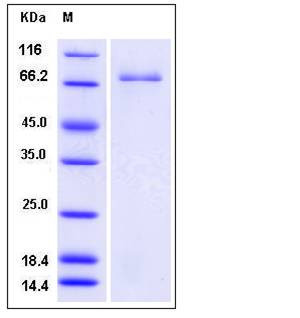Sus scrofa (Pig) Transferrin / TF Protein (His Tag)
TF
- 100ug (NPP3165) Please inquiry
| Catalog Number | P13656-W08H |
|---|---|
| Organism Species | Sus scrofa (Pig) |
| Host | Human Cells |
| Synonyms | TF |
| Molecular Weight | The secreted recombinant Sus scrofa (Pig) transferrin comprises 705 amino acids and has a predicted molecular mass of 78.3 kDa. It migrates as an approximately 72 kDa band in SDS-PAGE under reducing conditions. |
| predicted N | Gln 22 |
| SDS-PAGE |  |
| Purity | > 90 % as determined by SDS-PAGE |
| Protein Construction | A DNA sequence encoding the pig (Sus scrofa) transferrin (NP_001231582.1) (Met 1-Thr 715) was fused with the a polyhistidine tag at the C-terminus. |
| Bio-activity | 1. Measured by its ability to bind human His-TFRC (cat: 11020-H07H) functional ELISA. 2. Measured in a serum-free cell proliferation assay using MCF-7 human breast cancer cells. Karey, K.P. et al. (1988) Cancer Research 48:4083. The ED50 for this effect is typically 0.01-0.04 μg/mL. |
| Research Area | Cardiovascular |Blood |Other in Blood |
| Formulation | Lyophilized from sterile PBS, pH 7.4 1. Normally 5 % - 8 % trehalose and mannitol are added as protectants before lyophilization. Specific concentrations are included in the hardcopy of COA. |
| Background | Transferrin is a glycoprotein with an approximate molecular weight of 76.5 kDa. This glycoprotein is thought to have been created as a result of an ancient gene duplication event that led to generation of homologous C and N-terminal domains each of which binds one ion of ferric iron. The function of Transferrin is to transport iron from the intestine, reticuloendothelial system, and liver parenchymal cells to all proliferating cells in the body. This protein may also have a physiologic role as granulocyte / pollen-binding protein (GPBP) involved in the removal of certain organic matter and allergens from serum. Transferrins are iron binding transport proteins which bind Fe3+ ion in association with the binding of an anion, usually bicarbonate. This transferrin binds only one Fe3+ ion per protein molecule. Transports iron ions from the hemolymph into the eggs during the vitellogenic stage. Transferrins are iron binding transport proteins which can bind two Fe(3+) ions in association with the binding of an anion, usually bicarbonate. It is responsible for the transport of iron from sites of absorption and heme degradation to those of storage and utilization. Serum transferrin may also have a further role in stimulating cell proliferation. When a transferrin loaded with iron encounters with a transferring receptor on cell surface, transferring binds to it and, as a consequence, is transported into the cell in a visicle by receptor-mediated endocytosis. The PH is reduced by hydrogen iron pumps. The lower pH causes transferrin to release its iron ions. The receptor is then transported through the endocytic cycle back to the cell surface, ready for another round of iron uptake. Each transferrin molecule has the ability to carry two iron ions in the ferric form. |
| Reference |
